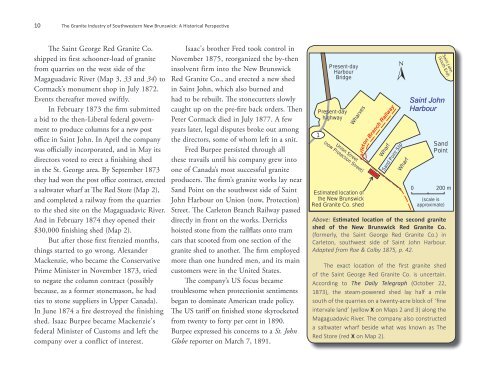The Granite Industry of Southwestern New Brunswick: A Historical ...
The Granite Industry of Southwestern New Brunswick: A Historical ...
The Granite Industry of Southwestern New Brunswick: A Historical ...
Create successful ePaper yourself
Turn your PDF publications into a flip-book with our unique Google optimized e-Paper software.
10 <strong>The</strong> <strong>Granite</strong> <strong>Industry</strong> <strong>of</strong> <strong>Southwestern</strong> <strong>New</strong> <strong>Brunswick</strong>: A <strong>Historical</strong> Perspective<br />
<strong>The</strong> Saint George Red <strong>Granite</strong> Co.<br />
shipped its first schooner-load <strong>of</strong> granite<br />
from quarries on the west side <strong>of</strong> the<br />
Magaguadavic River (Map 3, 33 and 34) to<br />
Cormack’s monument shop in July 1872.<br />
Events thereafter moved swiftly.<br />
In February 1873 the firm submitted<br />
a bid to the then-Liberal federal government<br />
to produce columns for a new post<br />
<strong>of</strong>fice in Saint John. In April the company<br />
was <strong>of</strong>ficially incorporated, and in May its<br />
directors voted to erect a finishing shed<br />
in the St. George area. By September 1873<br />
they had won the post <strong>of</strong>fice contract, erected<br />
a saltwater wharf at <strong>The</strong> Red Store (Map 2),<br />
and completed a railway from the quarries<br />
to the shed site on the Magaguadavic River.<br />
And in February 1874 they opened their<br />
$30,000 finishing shed (Map 2).<br />
But after those first frenzied months,<br />
things started to go wrong. Alexander<br />
Mackenzie, who became the Conservative<br />
Prime Minister in November 1873, tried<br />
to negate the column contract (possibly<br />
because, as a former stonemason, he had<br />
ties to stone suppliers in Upper Canada).<br />
In June 1874 a fire destroyed the finishing<br />
shed. Isaac Burpee became Mackenzie's<br />
federal Minister <strong>of</strong> Customs and left the<br />
company over a conflict <strong>of</strong> interest.<br />
Isaac's brother Fred took control in<br />
November 1875, reorganized the by-then<br />
insolvent firm into the <strong>New</strong> <strong>Brunswick</strong><br />
Red <strong>Granite</strong> Co., and erected a new shed<br />
in Saint John, which also burned and<br />
had to be rebuilt. <strong>The</strong> stonecutters slowly<br />
caught up on the pre-fire back orders. <strong>The</strong>n<br />
Peter Cormack died in July 1877. A few<br />
years later, legal disputes broke out among<br />
the directors, some <strong>of</strong> whom left in a snit.<br />
Fred Burpee persisted through all<br />
these travails until his company grew into<br />
one <strong>of</strong> Canada’s most successful granite<br />
producers. <strong>The</strong> firm’s granite works lay near<br />
Sand Point on the southwest side <strong>of</strong> Saint<br />
John Harbour on Union (now, Protection)<br />
Street. <strong>The</strong> Carleton Branch Railway passed<br />
directly in front on the works. Derricks<br />
hoisted stone from the railflats onto tram<br />
cars that scooted from one section <strong>of</strong> the<br />
granite shed to another. <strong>The</strong> firm employed<br />
more than one hundred men, and its main<br />
customers were in the United States.<br />
<strong>The</strong> company’s US focus became<br />
troublesome when protectionist sentiments<br />
began to dominate American trade policy.<br />
<strong>The</strong> US tariff on finished stone skyrocketed<br />
from twenty to forty per cent in 1890.<br />
Burpee expressed his concerns to a St. John<br />
Globe reporter on March 7, 1891.<br />
Present-day<br />
Harbour<br />
Bridge<br />
Present-day<br />
highway<br />
1<br />
Wharves<br />
Union Street<br />
(now Protection Street)<br />
Estimated location <strong>of</strong><br />
the <strong>New</strong> <strong>Brunswick</strong><br />
Red <strong>Granite</strong> Co. shed<br />
Wharf<br />
Sand Point Slip<br />
Wharf<br />
Saint John<br />
(South End)<br />
Saint John<br />
Harbour<br />
Sand<br />
Point<br />
0 200 m<br />
(scale is<br />
approximate)<br />
Above: Estimated location <strong>of</strong> the second granite<br />
shed <strong>of</strong> the <strong>New</strong> <strong>Brunswick</strong> Red <strong>Granite</strong> Co.<br />
(formerly, the Saint George Red <strong>Granite</strong> Co.) in<br />
Carleton, southwest side <strong>of</strong> Saint John Harbour.<br />
Adapted from Roe & Colby 1875, p. 42.<br />
<strong>The</strong> exact location <strong>of</strong> the first granite shed<br />
<strong>of</strong> the Saint George Red <strong>Granite</strong> Co. is uncertain.<br />
According to <strong>The</strong> Daily Telegraph (October 22,<br />
1873), the steam-powered shed lay half a mile<br />
south <strong>of</strong> the quarries on a twenty-acre block <strong>of</strong> ‘fine<br />
intervale land’ (yellow X on Maps 2 and 3) along the<br />
Magaguadavic River. <strong>The</strong> company also constructed<br />
a saltwater wharf beside what was known as <strong>The</strong><br />
Red Store (red X on Map 2).
















